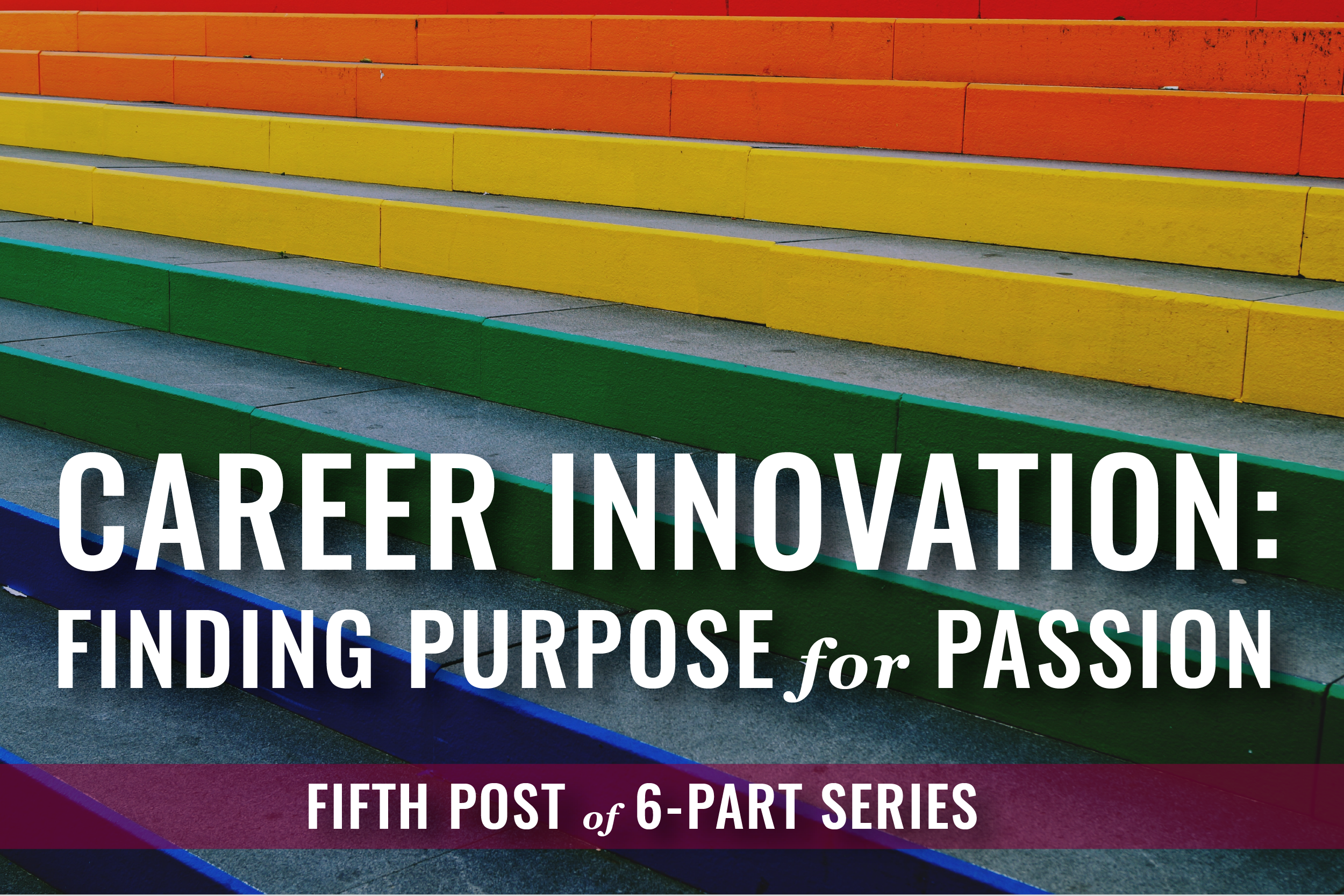Those who thrive most in their careers are fueled by their sense of purpose. Find out how to pivot your work as a lawyer into the right career for your passion.
The difference between working to survive as a lawyer and working to thrive at it is a question of how effectively you’re adapting. And as a human, you can always learn to adapt better. This post offers the fourth of five workbooks in our Career Research and Development Series, introduced here.
Before you begin this workbook, we strongly encourage you to complete:
- Workbook 1: STRENGTHS, which will guide you through an analysis of your Strengths, Weaknesses, and Opportunities and where to strategically invest your time and effort.
- Workbook 2: VALUES, which will guide you through learning what drives your behavior and how to harness it for the right work as a lawyer.
- Workbook 3: BRAND, which will guide you through crafting the right messages to communicate how you work as a lawyer.
To provide for a living, your skills and brand must fit for today’s opportunities. But to sustain a career, your work must fit you. You start with you. You might end up with a significant career pivot or just a slight shift. Either way, you will feel empowered.
Fear mixed into your excitement is normal and healthy. But if that fear creates inertia for you, consider using help from one of the clinicians at LCL, who can help you identify obstacles with motivation.
As you understand your passion more deeply, you find more opportunities to develop and grow, which expands your universe of solutions to the problem of how to generate enough income to live. it solve this challenge with innovation. Innovative thinking drives a career pivot.
But, first you must face your default reactions to challenges and conflict and your unconscious biases to find out if they are pushing you forward, holding you back, or sending you in the wrong direction and away from happiness and success.
In this step, you will learn how to get unstuck, change how you think, and notice more opportunities. You will:
- Reframe your thinking to think differently about your challenges and options to address them
- Embrace an entrepreneurial mindset and use it to notice more options to investigate
- Find a new career path that is a better fit between your skills and brand and reality today
ACTION STEPS CHECKLIST. This workbook will guide you through activities in two parts: Your Position and Your Move.
▢ Make your passion conscious and use it. Write your story of self.
▢ Evaluate the fit between your present career path, using your present brand and skills.
▢ Climb down the ladder of inference and change assumptions that are holding you back or pushing you in the wrong direction.
▢ Learn how to use the IDEA strategy for a career pivot.
PART ONE: YOUR POSITION
ACTIVITY 1: Examine Your Story.
Stories inspire and teach us how to think, feel, and what to do. Stories of how you faced challenges, the choices you made, and the outcomes your experienced are keys to uncovering and making fully conscious your passion and identity.
Once you know your passion and identity, you can choose to repurpose it to other challenges with a career pivot. When your story involves too much of a pain hurdle to handle on your own, you’re in a position to make a breakthrough. But it might feel like it could lead to a breakdown. LCL’s psychologists can help, and are a free and confidential service for Massachusetts lawyers, law students, and other legal professional. Just call 617 482 9600 to set up a time to talk. Our identities are linked to our careers. Learn to control yours — don’t let it control you.
When you write a story of the choice points in your life, describe the setting, characters, and plot. Use those elements to express the conditions contributing to the challenges you faced, how you chose to handle it, and the outcomes you perceived.
- Consider Your Challenges: Why were they challenges for you? What made them challenging for you?
- Consider Your Choices: Why did you choose to address each challenge? Why did you address each challenge in the way you chose? Where did you get the courage and tenacity to address it or why did you choose to avoid it? How did it feel? Why did you think you could or could not address it? The choices to face challenges comes from your passion. This is where you find your deep identity and opportunities to repurpose your passion.
- Consider Your Outcomes: What happened? How did it feel? What did you learn about yourself, your family, your peers, your target market, your competition? How does the way you feel today connect back to those outcomes?
After you’ve written your story, you’ll revisit and revise it as your experiences continue and further inform it. Share your story with others and notice what elements engage which people. Find out which people identify with passions similar to yours and trust your choices. This is your target market, broadly. And as you explore more narrow opportunities within it, you can figure out a way to help them and receive compensation for your time.
Use this Activity Sheet (and as many blank pages as you need!) to review the life experiences that shape your story.
ACTIVITY 2: Visualize on a Mind Map
Human brains seek patterns and are typically highly visually oriented. Translating your story of Self to a Mind Map offers a visual way to explore your passion and identity to illuminate who you are, what you’re interested in, the lifestyle you prefer, your skills and your weaknesses.
Use this Activity Sheet to post words and images on a mind map to see new information about yourself.
ACTIVITY 3: Evaluate Your Career Path Viability
Organizing how you understand the viability of your career path into component elements can help you interpret the information more clearly.
Use this Activity Sheet to answer questions and understand how to interpret them for insight.
PART TWO: YOUR MOVE
ACTIVITY 1: Assess Grit + Growth Mindset
If your levels of grit and or learning mindset are too low, update your SWOT analysis and make a plan to increase them. Your plan will need to cover the following efforts.
Develop Grit = Develop Practice Habits
- Practice is about making continuous improvement day after day with hard work and resilience.
- Resilience is the ability to pick yourself up, brush yourself off, and try again after a mistake or failure. It is seeing mistakes or failure as data and an opportunity to learn more.
- Find your desire to look forward and grow.
- 10,000 hours of practice over 10 years is the average for mastery of a skill.
Develop Practice
- Assess your present state then set a stretch goal that is one narrow aspect of your overall performance.
- Strive to improve that specific weakness.
- Seek out challenges that you can’t yet meet.
- Practice then perform then seek out feedback on what you did wrong so that you can fix it.
- Rest then repeat
Presume Results Will Follow
- Make the connection between your effort and your improvement.
- What is interfering with your ability to put in the effort to see improvements? What can you do to reduce or eliminate the interference?
- Be your own best friend. What self-talk do you notice? Is it helpful or hurtful? Change hurtful into helpful self-talk.
Examine Your Fixed Mindset and Its Limitations
- Compare the two types of mindsets – growth and fixed.
- Read a scientific article about the growth mindset to challenge your thinking.
- People with a fixed mindset lose confidence quickly with setbacks.
Develop Your Growth Mindset through Practice.
- Notice how you feel as you consider quitting work on an effort you’d previously enjoyed.
- Picture your brain forming new connections as you practice to push through the difficulty without quitting.
- Seek out constructive criticism.
Take the Grit Assessment here.
Take the Mindset Assessment here.
ACTIVITY 2: Climb Down Ladder of Inference
We can use the Ladder of Inference again to assess whether you’re ready for a career pivot. We need to focus on the assumptions, beliefs, and positions that affect your thinking, feelings, and decisions about making changes in your career.
Use this Activity Sheet to identify how your worldview is influencing your decisions about a substantial career move.
ACTIVITY 3: Pivot Your Career with the IDEA Strategy
When most people notice obstacles and risks, they think of them as dangerous mistakes to avoid. It’s more difficult to see the opportunities in an obstacle and the manageability of a risk.
You can avoid the fast-thinking that forecloses opportunities by following a thought process that focuses on intentional Inquiry and Design.
- Inquiry: Noticing and questioning more with curiosity
- Design: Planning, trying out, revising plan, doing it again
Focusing on Inquiry and Design cultivates substantive innovation. Focusing on Adjustment and Execution yields operational innovation. A substantive career innovation is a pivot to doing something new and different, or for a new and different target market. Operational innovations increase profitability by reducing resources and improving efficiencies.
Operational innovation doesn’t solve problems stemming from an ongoing drop in demand for whatever you offer the market. If your biggest threats come in the form of automation, you’ll need to focus on operational innovation to leverage the status quo for your short run survival — but you need to be simultaneously focused on making substantial innovations to make your career thrive in the long run.
Use this Activity Sheet to practice recognizing substantial innovation opportunities after reading or watching The Big Short.
CONCLUDE WITH ACTION:
In this workbook, you faced the reality and challenge that sometimes your existing skill set and brand aren’t viable as a career in today’s market. You explored your grit and learning mindset and made plans to increase both skills so you can respond to today’s opportunities. You wrote your story of self and translated it into a visual mindmap. You explored the pros and cons of a career pivot and made a decision about whether or not to pivot.
List the actions you can take and plan our precise times you will do them:
- What will do today and tomorrow to change your routines?
- When will you update your environmental scanning map?
- How often will you use the Ladder of Inference tool?
- What is innovation and how will you use the IDEA strategy for a career pivot?
- How will you update your SWOT Analysis?
Congratulations on finishing Workbook 4! The last workbook will show you how to turn your commitment to better work into action.
- PATH [Workbook 5]. Chart your course forward with clear goals, a step-by-step action plan, and insight for implementation accountability.




